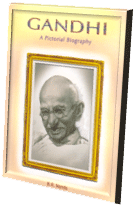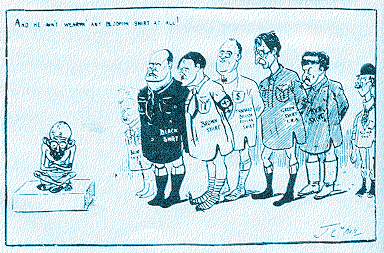
P.O. SEVAGRAM, DIST.WARDHA 442102, MS, INDIA. Phone: 91-7152-284753
FOUNDED BY MAHATMA GANDHI IN 1936
BIOGRAPHY OF GANDHI
GANDHI - A PICTORIAL BIOGRAPHY
by Shri B. R. Nanda

GANDHI
- A PICTORIAL BIOGRAPHY
Shri B. R. Nanda
Table of Contents
- About Gandhi
- Childhood
- Off To England
- Briefless Barrister
- In The 'Dark Continent'
- The Young Politician
- Satyagraha Struggle In South Africa
- The Making Of The Mahatma
- Return To India
- Gandhi's Ashram
- World War I
- Rowlatt Bills
- Nonviolent Non-cooperation
- Arrest And Imprisonment
- Reaction And Recovery
- Declaration Of Complete Independence
- Gandhi-Irwin Pact
- Round Table Conference
- In London
- Resumption Of Struggle
- Campaign Against Untouchability
- A New Deal For The Village
- The New Constitution
- Hindu-Muslim Antagonism
- Nonviolence In A Violent World
- Cripps Mission
- "Quit India"
- Simla Conference
- Cabinet Mission
- Communal Conflagration
- Partition of India
- Mission of Peace
- The End
- Gandhi and Nonviolence
About This Book
This is the first pictorial biography of Gandhi in which the narrative-concise, readable and incisive is illustrated with contemporary photographs and facsimiles of letters, newspaper reports and cartoons, adding up to a fascinating flash-back on the life of Mahatma Gandhi and the struggle for Indian freedom led by him. There is a skilful matching in this book of text and illustrations, of description and analysis and of concrete detail and large perspective. This pictorial biography will revive many memories in those who have lived through the Gandhian era; it should also be of interest to the post-independence generation.
About Author
Shri B. R. Nanda - former Director, Nehru Memorial Museum and Library, New Delhi. His full-scale biography of Mahatma Gandhi has been published in India, Britain and the U.S.A. and translated into French, Spanish, Italian and several other languages
Chapter-24 : Nonviolence In A Violent World

The separatist ideology was to receive a fillip from the outbreak of the Second by Nehru in international affairs, Gandhi sympathized with the victims of Fascist and Nazi aggression. Gandhi's own life had been one long struggle against the forces of violence. For more then thirty years he had been experimenting with technique-Satyagraha-which, while eschewing violence, was designed to resolve conflicts.
Gandhi's ideas on non-violence had matured over many years. In the Boer War and the Fist World War he had raised ambulance units and enlisted soldiers for the British Empire. The fact that he not handled a gun himself did not, in his opinion, make a material difference. As he confessed later: "There is no defence for my conduct only in the scales of non-violence (ahimsa). I draw no distinction between those who wield weapons of destruction and those who do Red Cross work. Both participate in war and advance its cause. Both are guilty of the crime of war. But even after introspection during all these years, I feel that in the circumstances in which I found myself I was bound to adopt the course I did."
The Indians whom Gandhi led in the battle fronts of the Boer War or exhorted to join the British Indian army in 1914-18 did not believe in non-violence; it was not repugnance to violence, but indifference or cowardice which had kept them from bearing arms. Believing as he did in those days in the British Empire, as a benign institution, Gandhi also thought that as citizens of the Empire, Indians had duties as well as rights; one of these duties was to participate in the defence of the Empire.
In the twenty years which spanned the First and Second World Wars, Gandhi's faith in the British Empire had been irrevocably shaken. At the same time his own belief in the power of non-violence had grown. As the threat of war grew and the forces of violence gathered momentum in the late thirties, he felt more strongly than ever that at that moment of crisis in world history, he had a message for India and India had a message for the bewildered humanity. Through the pages of Harijan, his weekly paper, he expounded the non-violent approach to military aggression and political tyranny He advised the weaker nations to defend themselves not by seeking protection from better armed states, but by non-violent resistance to the aggressor. A non-violent Abyssinia, he explained, needed no arms and succour from the League of Nations; if every Abyssinian man, woman and child refused cooperation, willing or forced, with the Italians, the aggressor would have to walk over the dead bodies of their victims and to occupy the country without the people.
It may be argued that Gandhi was making a heavy overdraft upon human endurance. It required supreme courage for a whole people to die to the last man, woman and child, rather than surrender to the enemy. Gandhi's non-violent resistance was thus not a soft doctrine - a convenient refuge from a dangerous situation. Nor was it an offer on a silver platter to the dictators of what they plotted to wrest by force. Those who offered non-violent resistance had to be prepared for the extreme sacrifice.